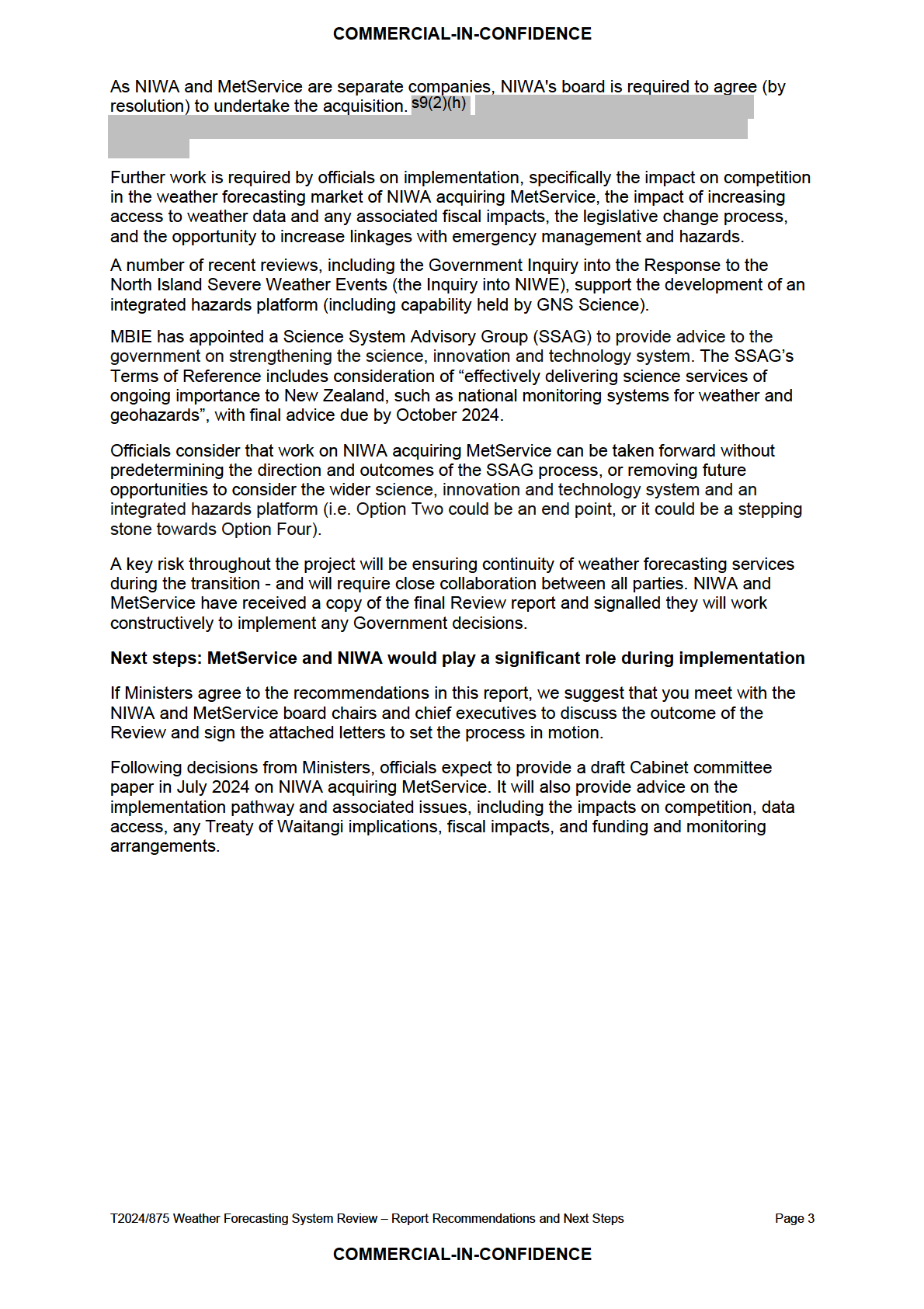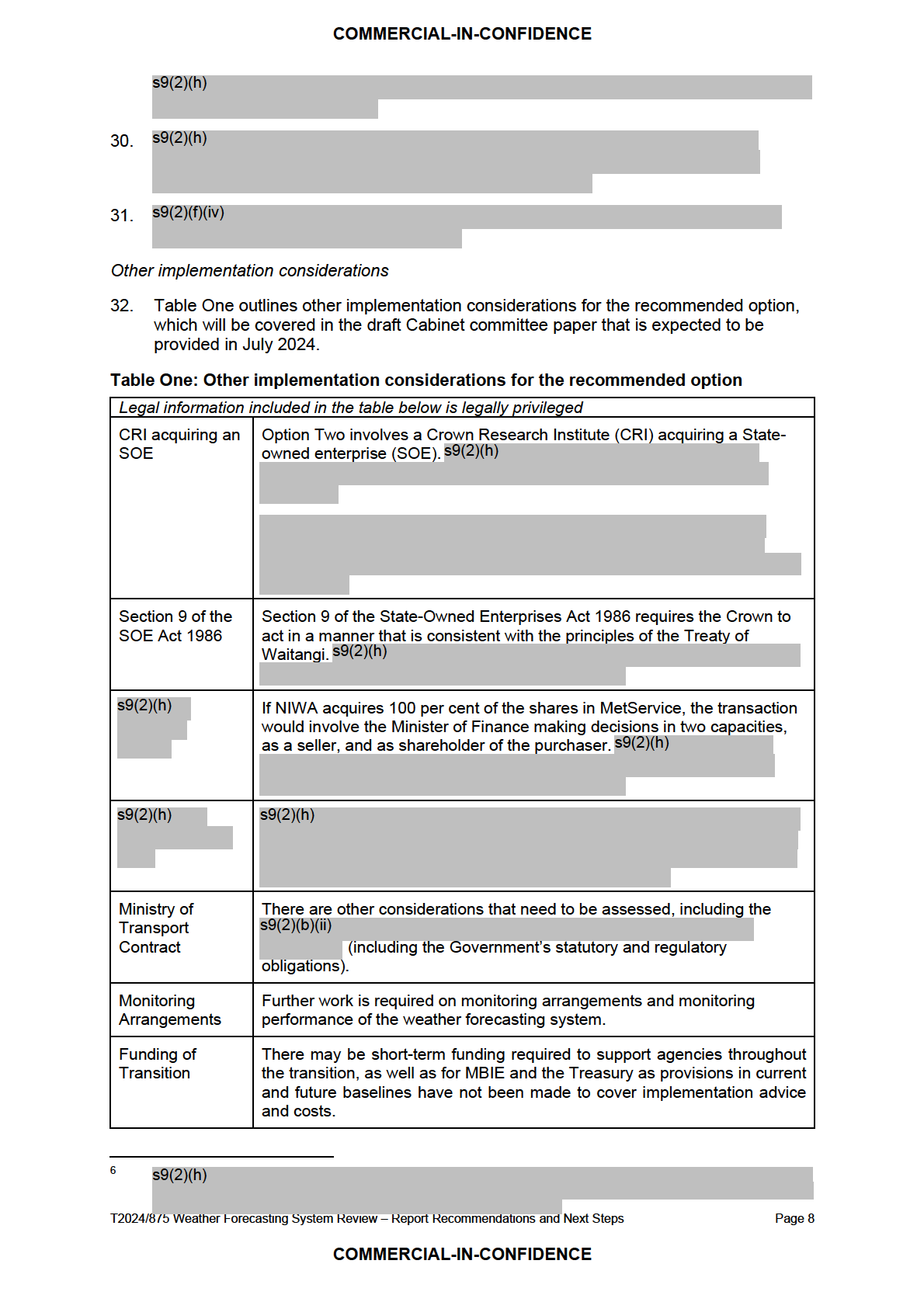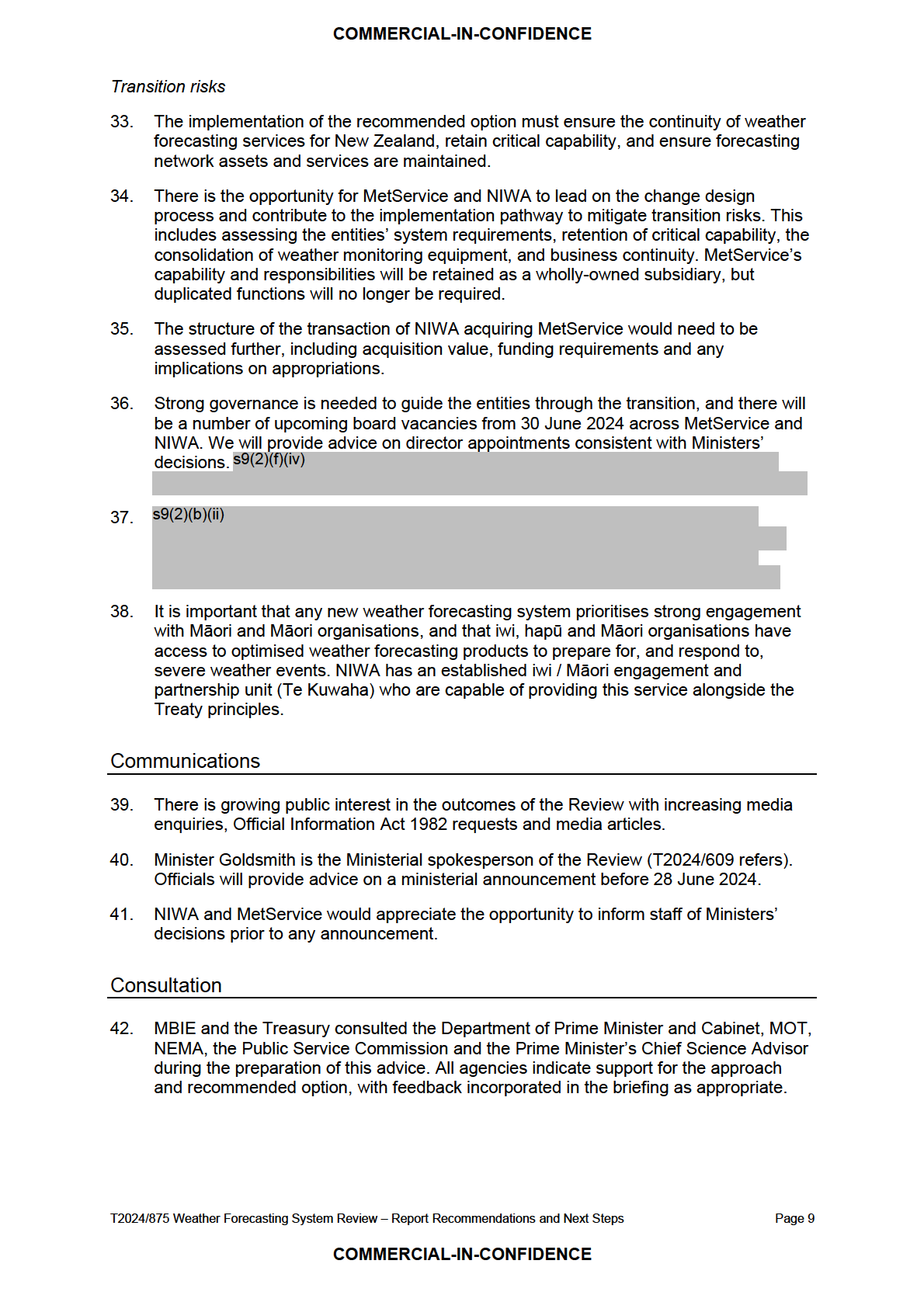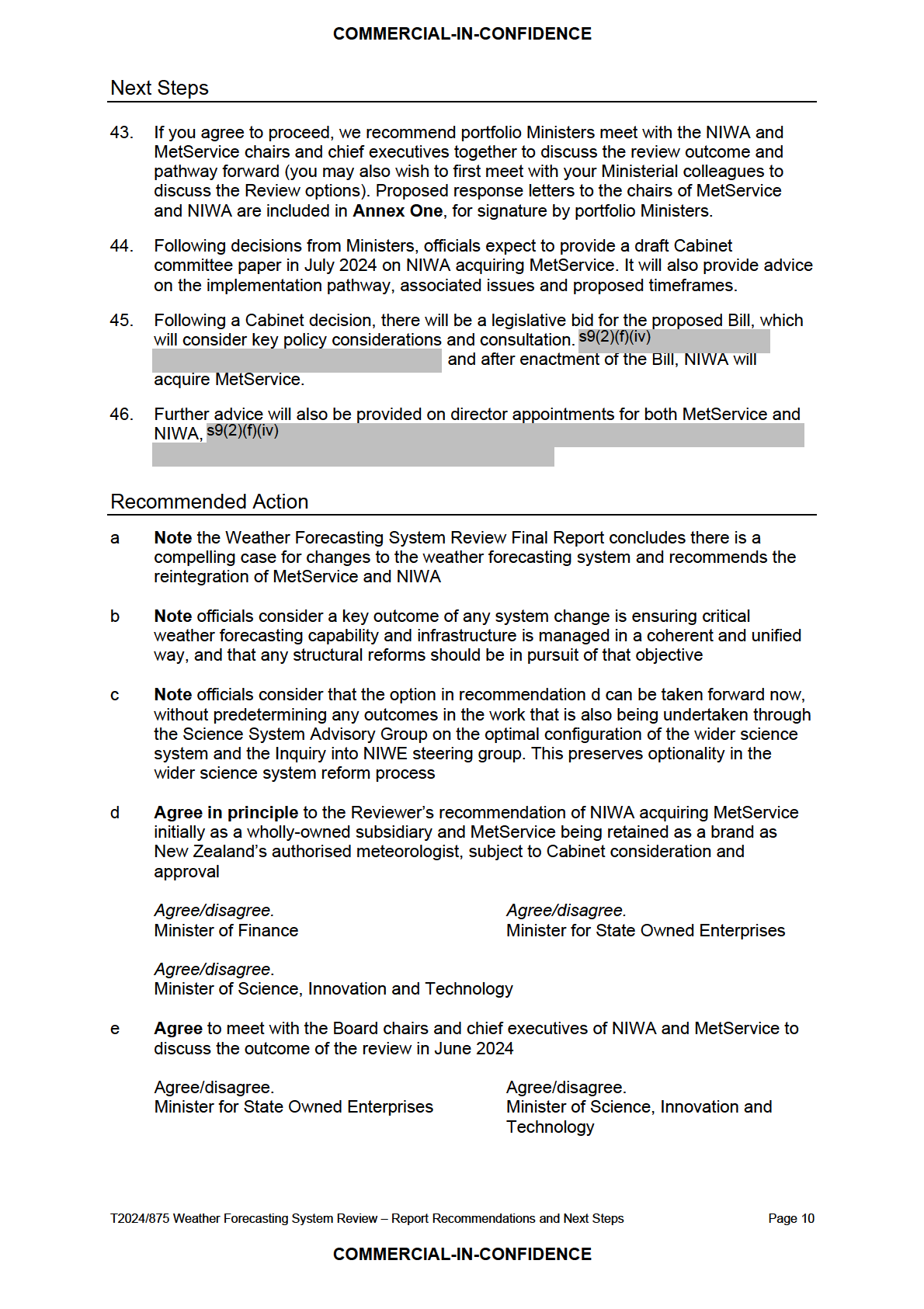
 COMMERCIAL-IN-CONFIDENCE
Joint Report:
COMMERCIAL-IN-CONFIDENCE
Joint Report:
Weather Forecasting System Review – Report
Recommendations and Next Steps
Date:
31 May 2024
Report No:
T2024/875; MBIE 2324-2570
File Number:
SE-2-10-2-2
Action sought
Action sought
Deadline
Minister of Finance
Note the submission of the Weather Forecasting
28 June 2024
(Hon Nicola Willis)
System Review Final Report
Agree to the recommended option for the Weather
Forecasting System
Minister for State Owned
28 June 2024
Enterprises
Note the submission of the Weather Forecasting
(Hon Paul Goldsmith)
System Review Final Report
Agree to the recommended option for the Weather
Minister of Science, Innovation and Forecasting System
28 June 2024
Technology
Sign the attached letters to MetService and NIWA
(Hon Judith Collins KC MP)
Minister for Emergency
28 June 2024
under the
Management and Recovery
(Hon Mark Mitchell)
Note the submission of the Weather Forecasting
Associate Minister of Transport
System Review Final Report
28 June 2024
(Hon Matt Doocey)
Associate Minister of Finance
28 June 2024
(Hon David Seymour)
Contact for telephone discussion (if required)
Name
Position
Telephone
1st Contact
Released
Kirk
Senior Analyst, Commercial and Institutional
s9(2)(a)
s9(2)(a)
McDowal
Performance
(wk)
(mob)
Lars Piepke Manager, Commercial and Institutional
s9(2)(a)
s9(2)(a)
Performance
(wk)
(mob)
Andrew
Principal, Science, Innovation and Technology,
s9(2)(a)
McLoughlin Entity Performance and Monitoring
n/a
(mob)
Nicola Scott Manager, Science, Innovation and Technology,
s9(2)(a)
Official Information Act 1982
Entity Performance and Monitoring
n/a
(mob)
Minister’s Office actions (if required)
Return the signed report to the Treasury and the Ministry of Business, Innovation and Employment.
Send the signed letters to MetService and NIWA.
Note any feedback on
the quality of the report
Enclosure:
Yes (attached)
Annex One: Letters to MetService and NIWA (Treasury 4965732.1)
Annex Two: Final Report of the Weather Forecasting System Review (Treasury 4964896.1)
Treasury:4937951v3
IN-CONFIDENCE
COMMERCIAL-IN-CONFIDENCE
Joint Report: Weather Forecasting System Review – Report
Recommendations and Next Steps
Executive Summary
There are lost synergies and risks from a fragmented weather forecasting system
The final Sapere (Reviewer) report from the Weather Forecasting System Review (the
Review) recommends improvements to New Zealand’s system arrangements to address
increasing risks from climate change related severe weather events. The Review identified:
•
duplicated effort and investment, and a lack of integration between national climate
science, forecasting, hydrology and coastal hazards capability;
•
an increasing risk to public safety and property due to uncertainty over weather
warnings and the flow of information between relevant agencies;
•
a compelling case for change to current institutional arrangements between the
Meteorological Service of New Zealand Limited (MetService) and National Institute of
Water and Atmospheric Research Limited (NIWA); and
•
a need to improve data access to support the application of weather data, and explore
investments in data access to support information sharing and drawing together
different insights.
Structural change is needed to optimise weather forecasting system arrangements
The report recommends a re-integration of meteorology services with climate science,
hydrology, and oceanography (along with wider recommendations such as improved data
under the
access). The following options considered in the Review report have the potential to deliver
the necessary system improvements:
•
NIWA acquiring MetService initially as a wholly-owned subsidiary and MetService
being retained as a brand as New Zealand’s authorised meteorologist. Design work on
integrating some capabilities would be undertaken in the lead up to acquisition which
could result in changes to MetService’s suite of capabilities. Further work could
consider whether a full amalgamation of the two entities wil best meet New Zealand’s
needs (the Reviewer’s and officials’ recommendation) (Option Two).
•
The establishment of a new public weather service entity that includes weather
forecasting capabilities of MetService and NIWA (Option Three).
Released
•
Integrating weather forecasting system capabilities and capabilities relating to other
natural hazards through MetService, NIWA, and the Institute of Geological and Nuclear
Sciences Limited (GNS Science) (Option Four).
Officials seek Ministers’ in-principle approval to commence work on NIWA acquiring
MetService
The Ministry of Business Innovation and Employment (MBIE), the Treasury and the Ministry
Official Information Act 1982
of Transport (MOT) support the Reviewer’s recommendation of Option Two. While the
National Emergency Management Agency (NEMA) has indicated a preference for Option
Four, NEMA supports Option Two as a step towards this.
MBIE, the Treasury and NEMA also support the recommendation to improve data access to
support the application of weather data.
Of icials seek Ministers’ in-principle approval for NIWA acquiring MetService and starting the
process for addressing a number of urgent issues with the current system, such as unified
public weather warning messaging, and a more coordinated response to any future weather
events.
T2024/875 Weather Forecasting System Review – Report Recommendations and Next Steps
Page 2
COMMERCIAL-IN-CONFIDENCE

under the
Released
Official Information Act 1982
COMMERCIAL-IN-CONFIDENCE
Joint Report: Weather Forecasting System Review – Report
Recommendations and Next Steps
Purpose of Report
1.
The purpose of this report is to provide the Weather Forecasting System Review (the
Review) final report, seek agreement to the recommended option and proposed next
steps.
The Weather Forecasting System Review Report concludes there is a
compelling case for change in the current weather forecasting system
2.
The current arrangements in the weather forecasting system are inefficient, evident by
duplicated effort and investment, and a lack of integration between climate science,
forecasting, hydrology and coastal hazards. There is evidence of public uncertainty
through inconsistent messaging from two Crown-owned weather forecasters during
severe weather events. Decisions are not always informed by the latest information,
leading to increasing risk to public safety, property and the economy.
3.
Previous reviews in 2001, 2006 and 2018 also identified long-term risks associated
with existing institutional arrangements. Non-structural changes to improve
collaboration between the entities failed, such as a Memorandum of Understanding.
4.
There is now wide support for structural solutions to the problems identified in the
weather forecasting system to ensure it can address future climate-related weather
challenges and improvements to New Zealand’s emergency management system. The
under the
need for reform is supported in recent reviews including the Government Inquiry into
the Response to the North Island Severe Weather Events (the Inquiry into NIWE).
The Weather Forecasting System Review Report findings
5.
The purpose of the Review was to recommend the optimal arrangements in the
weather forecasting system to meet future weather-related challenges and the impacts
from climate change, rather than seek efficiency gains in the short-term.
6.
Recommendations of the Review include the structural configuration of the
Released
Meteorological Service of New Zealand Limited (MetService) and National Institute of
Water and Atmospheric Research Limited (NIWA), and appropriate arrangements for
access to weather data. Of icials consider the final report (
Annex Two) delivers on the
Terms of Reference (ToR) (T2024/430 refers).
7.
The Reviewer
1 interviewed over 50 stakeholders, received 145 responses to its survey
and held a workshop at the 2023 Meteorological Society of New Zealand annual
conference. The Reviewer held several meetings with MetService and NIWA and the
entities responded to information requests. MetService also provided an independent
Official Information Act 1982
submission for the Reviewer to consider.
8.
The final report highlights the increasing value public weather forecasting delivers to
society and the important role of government in the provision of public good weather
forecasts. However, the current institutional arrangements appear to be the root cause
for many issues identified in the Review, which is ultimately creating increasing risks to
public safety, property, and the economy.
1
Sapere Research Group Limited were selected to undertake the Review following a Request for Proposal process.
T2024/875 Weather Forecasting System Review – Report Recommendations and Next Steps
Page 4
COMMERCIAL-IN-CONFIDENCE
COMMERCIAL-IN-CONFIDENCE
9.
The current weather data access and management arrangements are also restrictive in
terms of cost and they limit innovation within the wider system. This is consistent with
findings from the 2018 review,
Weather Permitting: Review of open access to weather
data in New Zealand2, which found the New Zealand model is at the most commercial
and restrictive end of cost and limitations on data use. By international comparison,
New Zealand has relatively low public expenditure in funding weather forecasting
services.
The Report recommends NIWA acquiring MetService as a wholly-owned
subsidiary and then further work on amalgamating the two entities
10. The Reviewer considered a long-list of options in relation to funding, delivery and
regulatory levers and how the options would best position New Zealand to meet future
weather-related challenges. The report assesses five options for change, and three
options were considered to have the potential to achieve the optimal system state:
•
NIWA acquiring MetService initially as a wholly-owned subsidiary and MetService
being retained as a brand as New Zealand’s authorised meteorologist. Further
work would then be performed on whether a full amalgamation of the two entities
wil best meet New Zealand’s needs (
Option Two).
•
The establishment of a new public weather service entity that includes weather
forecasting capabilities of MetService and NIWA (
Option Three).
•
Integrating capabilities in relation to the weather forecasting system and
capabilities relating to other natural hazards through MetService, NIWA and the
Institute of Geological and Nuclear Sciences Limited (GNS Science) (
Option
under the
Four).
11. The Reviewer recommends
Option Two, a re-integration of meteorology services with
climate science, hydrology, and oceanography through NIWA acquiring MetService.
Broader recommendations
12. The Review contains a number of broader recommendations relating to monitoring,
funding, and in particular improved data access to support the application of weather
data and modelling. This would include reviewing data access policies and systems
and moving quickly to ensure greater transparency regarding what data exists, that all
publicly funded data is easily available, and that any costs of access are justifiable. The
Released
Reviewer noted that the cost of free open data access may be approximately $40
mil ion in lost revenue per annum.
Officials support the recommendation of NIWA acquiring MetService
Recommendation to reintegrate NIWA and MetService – Option Two
13. MBIE, the Treasury and the Ministry of Transport (MOT) support the Reviewer’s
Official Information Act 1982
recommendation of Option Two – NIWA acquiring MetService, subject to further work
from officials on the implementation process. While the National Emergency
Management Agency (NEMA) has indicated a preference for Option Four, NEMA is
supportive of Option Two as a step towards Option Four.
14. Of icials consider that re-integration of meteorology services through the acquisition
should be taken forward now as it will start to address a number of urgent issues within
the current system, including unified public weather warning messaging and support a
2
https:/ www.mbie.govt.nz/assets/5b3b826f79/weather-permitting-review.pdf
T2024/875 Weather Forecasting System Review – Report Recommendations and Next Steps
Page 5
COMMERCIAL-IN-CONFIDENCE
COMMERCIAL-IN-CONFIDENCE
more coordinated response to any future severe weather events, involves less risk
while maintaining service provision, without predetermining the Science System
Advisory Group’s (SSAG)
3 review recommendations, which has the mandate to assess
the integration of wider natural hazard and/or emergency management capability within
the weather forecasting system, and can engage with the Inquiry into NIWE cross-
government steering group.
15. NIWA may propose further amalgamation after the acquisition of MetService, and
officials wil provide advice to Ministers at that time.
The NIWA and MetService boards have indicated they wil work constructively to implement
Government decisions
16. Of icials provided the final report to the boards and chief executives of MetService and
NIWA but the report has not been shared more widely with staff. The entities both
agree that a single weather forecasting agency is in the best interests of New Zealand
but have dif erent views on how this is best achieved. Both boards have indicated they
wil work constructively to implement any Government decisions.
Consideration of Option Three
17. The Reviewer considered the establishment of a new public weather service entity that
includes weather forecasting capabilities of MetService and NIWA, an option consistent
with MetService’s submission
4.
18. The Reviewer concluded there are fewer net benefits from this option. MBIE and the
Treasury also consider that a new entity would not provide an entire research-to-
operations pathway as certain research capability would remain with NIWA, and may
create financial viability risk for NIWA due to the extent of capability removed, and the
under the
implementation process would take a longer time as it would require assets and
capability from both MetService and NIWA moving to a new entity.
Consideration of Option Four
19. Option Four could lead to substantive improvements in forecasting and warnings for
the emergency management system, addressing one of the key recommendations
from the Inquiry into NIWE. It has the potential to move towards the perceived best
practice of one warning system for multiple hazards, through the integration of weather
and geological hazards, which are being adopted internationally (for example, Japan,
as noted in Sapere’s Interim Report).
Released
20. The Inquiry into NIWE highlighted the emergency management system requires
change and the interdependencies with weather forecasting, and a cross-government
officials’ steering group is being established in response to its findings.
21. NEMA is concerned that progressing Option Two, and then revisiting Option Four later,
rather than addressing changes all at once, could lead to sustained uncertainty and
disruption to New Zealand’s weather forecasting system creating implications for the
emergency management system as a result. NEMA has noted that funding and
Official Information Act 1982
governance arrangements for New Zealand’s geohazards forecasting system (GeoNet)
are also being currently considered, so there are likely benefits to examining natural
hazard monitoring, forecasting and warning systems at present.
3
The SSAG’s Terms of Reference includes consideration of “effectively delivering science services of ongoing importance
to New Zealand, such as national monitoring systems for weather and geohazards”, and final advice is due by 30 October
2024.
4
MetService’s submission to the Review recommended a two-phase move to establish a new Crown entity with integrated
meteorological, oceanographic, hydrological, and climatological capabilities, and responsibility across the entire research-
to-operations pathway.
T2024/875 Weather Forecasting System Review – Report Recommendations and Next Steps
Page 6
COMMERCIAL-IN-CONFIDENCE

under the
Released
Official Information Act 1982

under the
Released
Official Information Act 1982

under the
Released
Official Information Act 1982

under the
Released
Official Information Act 1982

 COMMERCIAL-IN-CONFIDENCE
COMMERCIAL-IN-CONFIDENCE
f
If recommendation d is agreed,
agree for shareholding Ministers to sign the attached
letters to the chairs of MetService and NIWA (
Annex One), to initiate the acquisition
process
Agree/disagree.
Agree/disagree.
Minister of Finance
Minister for State Owned Enterprises
Agree/disagree.
Minister of Science, Innovation and Technology
g
Agree in principle to the Reviewer’s recommendation that access to weather data be
made more open within the weather forecasting system, subject to implementation
advice being provided, and noting there are likely fiscal implications and policy issues
to be addressed
Agree/disagree.
Agree/disagree.
Minister of Finance
Minister for State Owned Enterprises
Agree/disagree.
Minister of Science, Innovation and Technology
h
If recommendation d is agreed
, note of icials expect to provide a draft Cabinet
committee paper in July 2024 on NIWA acquiring MetService. It wil also provide advice
on the implementation pathway and associated issues
i
Note in the event a further amalgamation between NIWA and MetService is proposed
after the acquisition of MetService, of icials will provide advice to Ministers at that time.
under the
Lars Piepke
Nicola Scott
Manager, Commercial and Institutional
Manager, Science, Innovation and
Performance, The Treasury
Technology, Entity Performance and
Monitoring, MBIE
Released
Hon Nicola Willis
Hon Paul Goldsmith
Minister of Finance
Minister for State Owned Enterprises
_____/_____/_______
_____/_____/_______
Official Information Act 1982
Hon Judith Collins KC MP
Hon Mark Mitchell
Minister of Science, Innovation
Minister for Emergency Management
and Technology
and Recovery
_____/_____/_______
_____/_____/_______
T2024/875 Weather Forecasting System Review – Report Recommendations and Next Steps
Page 11
COMMERCIAL-IN-CONFIDENCE
COMMERCIAL-IN-CONFIDENCE
Hon Matt Doocey
Hon David Seymour
Associate Minister of Transport
Associate Minister of Finance
_____/_____/_______
_____/_____/_______
under the
Released
Official Information Act 1982
T2024/875 Weather Forecasting System Review – Report Recommendations and Next Steps
Page 12
COMMERCIAL-IN-CONFIDENCE








